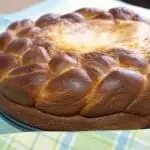Cypriot Flaounes are tasty Greek cheese pastries that are commonly eaten during the Easter season. The use of traditional Green spices give these Easter breads a flavor unlike anything you have tasted!

What are Cypriot Flaounes?
Flaounes (singular flaouna) are a cheese bread/pastry from Cyprus, an island off the coast of Greece. (While technically not a part of Greece, their culture and cuisine is very heavily Greek, hence our classification of this pastry as a “Greek” dish.)
Small, 3 inch, triangle flaounes, called flaouniteses or flaounoudes, can be found year round and are eaten as a snack or appetizer.
Larger versions are made during Holy Week, in preparation for Easter.
These breads are filled with a cheese mixture and seasoned with two unique Greek spices – mastic and mahlepi (mahlab) – as well as mint.
This combination of unique local spices and local cheese makes these pastries quite the treat.
But, if you want a taste of Easter in Cyprus without a trip to the island for ingredients, read on. We’ve got you covered!
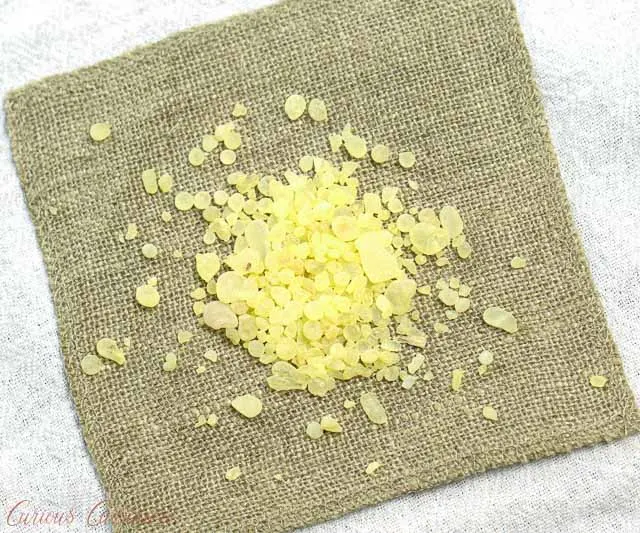
What is mastic gum?
Mastic gum or resin, also called masticha, is hardened sap harvested from a small evergreen tree, called a mastic.
This tree is found mainly on the Greek island of Chios.
Mastic resin typically comes in small pellets, called ‘tears’, and needs to be ground to a powder before using. It is often used in baked goods, drinks, and even ice-cream.
You can find mastic gum online or at Greek food stores.
What does mastic gum taste like?
Mastic resin tastes similar to what you would expect, knowing it is sap from an evergreen tree: slightly sweet and piney in flavor.
We found the flavor to also be a bit reminiscent of licorice. But it was very light in flavor overall.
What can I use instead of mastic?
With its unique piney flavor, there really aren’t any good substitutes for mastic.
However, some people suggest substituting vanilla, which would add a nod to its slight sweetness, but wouldn’t quite capture the other notes.
If we didn’t have it on hand, we would just omit it in this recipe.
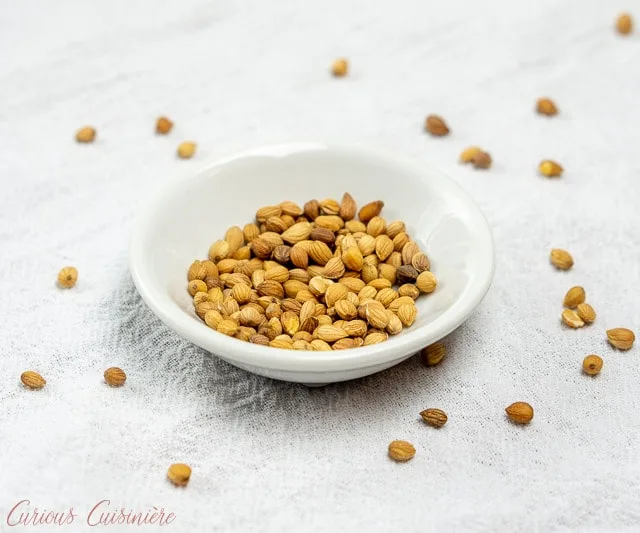
What is Greek Mahlepi?
Mahlepi (also called mahleb or mahlab) is made from the small pits of wild St. Lucy’s cherries.
The pits are often sold whole, but can also be found pre-ground.
Mahlepi is used in Greek cooking and baking (particularly in breads), and is also used in other Middle Eastern dishes.
You can find mahlepi online or in Greek food stores.
What does mahlab taste like?
Mahlab has a nutty and sweet flavor and fragrance. (You will definitely notice its fragrance as these flaounes are cooking.)
What can I use instead of mahlab?
If you don’t have mahlab, we would substitute it with almond extract (at half the called for amount) and cardamom (at 1/4 the called-for amount) or a pinch of anise.
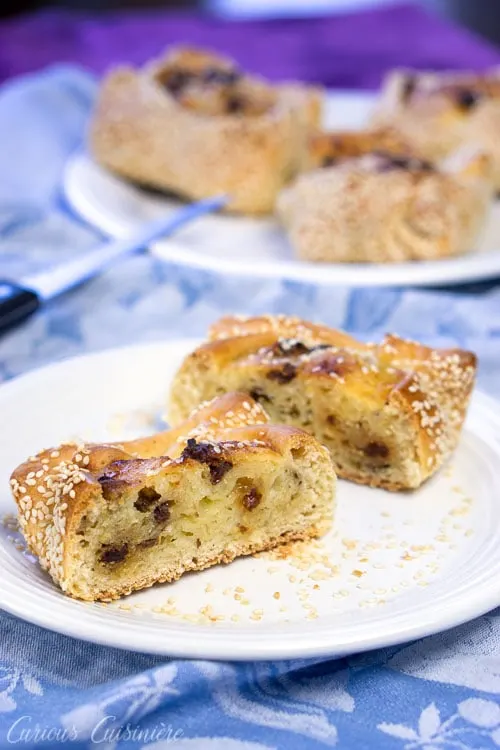
An Easter pastry
Traditionally, milk and eggs were not eaten during the fasting season of Lenten before Easter. In order to preserve the milk that was not being drunk, they made cheese. (The eggs were simply stored in a cool place.)
As you can imagine, by the end of the 40 days of Lent, they had a lot of eggs and cheese to use up!
Hence, these pastries and other Greek Easter foods featuring those ingredients.
What cheese do I use to make flaouna?
Traditionally, flaounes are made with the local Cypriot goat’s milk cheese called paphitiko.
As these pastries gained popularity in other parts of Greece, other cheeses began to be used, like halloumi.
And, as they gained further world-wide renown, in areas that Greek cheese was hard to come by, mild cheddar and Romano became popular substitutes.
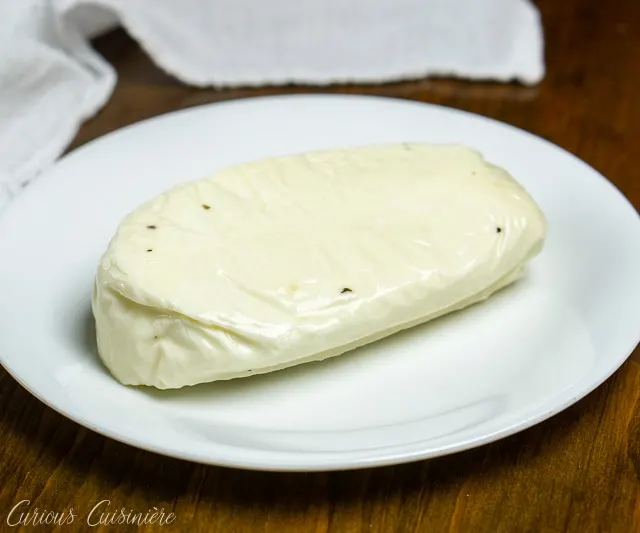
What does halloumi cheese taste like?
Halloumi cheese is a very unique cheese. It is soft, salty, and slightly squeaky.
In texture, it is similar to fresh white cheddar cheese curds or a very fresh mozzarella.
In flavor, it is mild, but a bit salty. Kind of reminiscent of feta or Romano, on the salt level, however less intense because of the mild flavor and soft nature.
What cheese is similar to halloumi?
Luckily, nowadays it is possible to find halloumi if you look for it in places with a good international cheese selection.
(We found some at World Market. And, Trader Joe’s also carries it seasonally.)
However, it can be expensive and sometimes hard to find. So, if you need a substitute for halloumi cheese a mild white cheddar or white cheddar cheese curds would get you close to the texture. Blending that with a little pressed feta or romano, for flavor, could do the trick.
Or, you could try a fresh mozzarella and add some extra salt.
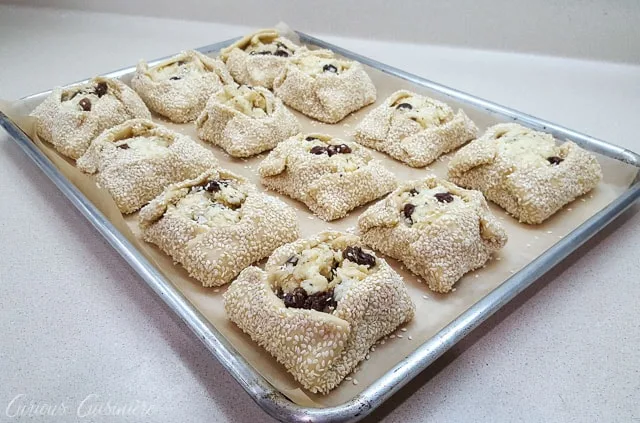
How to Make Flaounes
These Easter pastries are a bit labor intensive to make, which is why they are often a family affair, made on Holy Thursday or Good Friday in preparation for Easter.
The filling should be made a day before making the flaounes, to let the flavors of the spices really infuse the cheese before it is baked.
The day you want to make your cheese breads, call all hands on deck!
- Mix the dough and let it rise
- Roll the dough thin.
- Cut the dough. (It can be cut into squares, triangles, or circles, depending on your preference.)
- Brush the cut pieces with egg wash.
- Dunk the washed side in sesame seeds.
- Place filling on the clean side.
- Fold up the sides of the dough around the filling to create a little boat. Pinch the corners of the dough together to seal the filling in. (Leaving a little filling peaking through at the center of the pastry.)
- Brush the exposed filing with a little more egg wash.
- Bake!
Leftover dough pieces can be made into koulourakia, which might be why these are a popular Easter cookie.
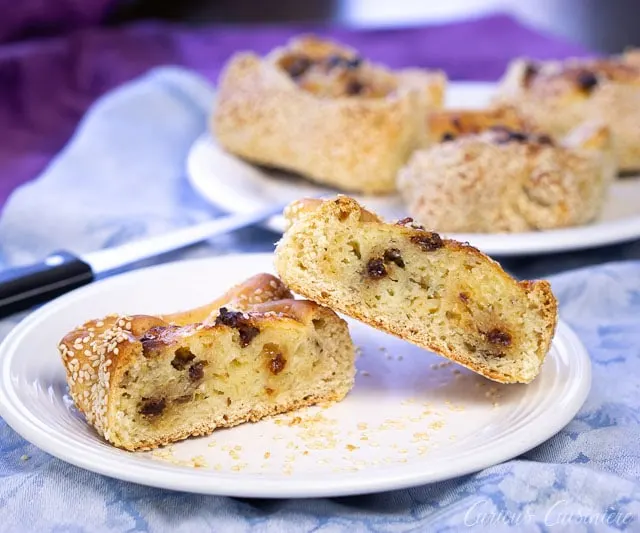
Our Greek Easter Flaounes Recipe
For our recipe for flaounes, we used half halloumi cheese and half mild, white cheddar. White cheddar is easy to find and less expensive than halloumi, but blending the two cheeses still gives a good flavor.
We were fortunate to be gifted some mahlepi and mastic from family after a trip they took to Greece.
If you can get your hands on some of these spices, they will take your Greek Easter baking experience to a new level.
However, if you can’t, don’t let that stop you from making these Easter breads. They are a fun treat and quite tasty even with some substitutions.
Cypriot Flaounes (Greek Easter Cheese Bread)
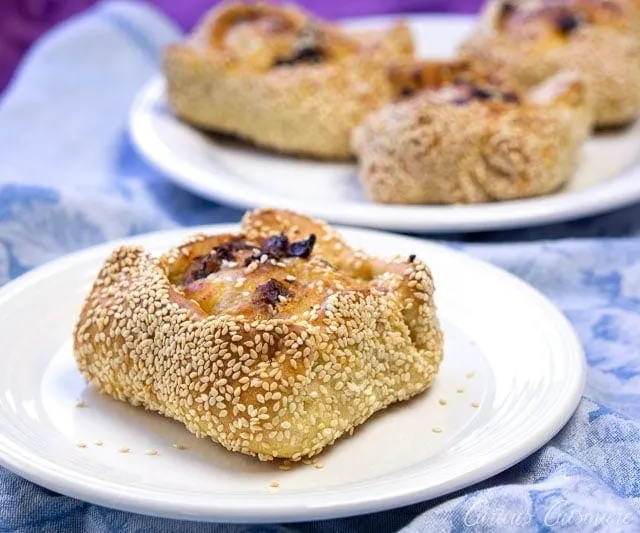
Cypriot Flaounes are tasty Greek cheese pastries that are commonly eaten during the Easter season.
Note: For best flavor, the filling for these cheese breads should be made the day before you want to bake your flaounes.
Ingredients
For The Filling
- 1 tsp mastic *
- 1 tsp mahleb **
- 1 tsp sugar
- 8 oz (228 g) haloumi cheese
- 8 oz (228 g) soft, mild cheddar
- 1c (115 g) raisins
- 1/2 c (84 g) semolina flour
- 1 tsp baking powder
- 1/2 tsp dry mint, crushed
- 2 eggs
For The Dough
- 2 1/4 tsp active dry yeast
- 1 1/4 c (300 ml) lukewarm milk, divided
- 1 tsp mastic *
- 1 tsp mahleb **
- 1 tsp sugar
- 4 c (512 g) flour
- 1 tsp baking powder
- 1/2 tsp salt
- 1/3 c olive oil
For The Topping
- 1 egg, beaten
- 1/2 c (70 g) sesame seeds
Instructions
Day 1 - Cheese Mixture Prep
- Using a mortar and pestle, pound the mastic and mahleb together with 1 tsp sugar until you have a fine powder.
- Grate the cheeses and mix them with the raisins, semolina flour, baking powder, pounded mixture, and crushed mint.
- Add the eggs, one by one, mixing until the cheese has come together as a firm mixture that can be shaped into a ball. (Less or more eggs may be needed depending on the moisture level of the cheese.)
- Cover the filling and refrigerate overnight, or at least 4 hours, to let the flavors come together.
Day 2 – Dough and Baking
- Remove cheese mixture from the refrigerator and let it come to room temperature while you prepare the dough.
- Mix yeast with 1/2 c lukewarm milk. Set aside for the yeast to hydrate.
- Pound the mastic and mahleb with 1 tsp sugar until fine.
- In a large bowl, mix the flour, baking powder, salt, and pounded mixture.
- Add the oil and rub it into the flour using your fingertips, until mixture has a sandy texture.
- Pour the softened yeast mixture into the flour and mix well with your hands.
- Add the remaining 3/4 c of lukewarm milk gradually, kneading with your hands as you add, and adding just enough to incorporate all the dry ingredients and create a firm dough that does not stick on your hands.
- Cover the dough and set it aside to rise for 1-2 hours, until nearly doubled.
- Place the sesame seeds into a medium plate or tray.
- Roll out the dough 1/8 inch thick (it should measure roughly 15x20 inches). Cut the dough into 5 inch squares. (Or cut the dough your desired shape and size.)
- Brush one side of the cut dough with the beaten egg and place it egg-side down onto the seeds.
- Place a heaping 1/4 cup of the cheese filling on top of the dough (on the un-seeded side).
- Brush the egg wash on the outer edges of the dough and fold them up towards the center (leaving the top center of the filling uncovered). Pinch the un-seeded side of the corners of the dough together to keep the sides in place over the filling.
- Place the shaped flaounes on a baking tray lined with parchment paper. Brush the exposed filling with a little beaten egg.
- Let the flaounes rise for 30-45 minutes, until slightly puffy.
- Near end of rising time, preheat your oven to 375F.
- Bake the flaounes for 30 min, until deeply golden.
- Serve with honey and cinnamon for a sweet treat or olives and sliced meat for savory.
Notes
* If you don't have mastic, simply omit it.
**If you don't have mahlab, substitute 1 tsp with 1/2 tsp almond extract and 1/4 tsp cardamom (or a pinch of anise).
Recommended Products
As an Amazon Associate and member of other affiliate programs, We earn from qualifying purchases.
Nutrition Information:
Yield:
12Serving Size:
1 flaounaAmount Per Serving: Calories: 468
If you liked this recipe, here are some similar dishes you may enjoy!

Sarah is one of Curious Cuisiniere’s founding duo. Her love for cultural cuisines was instilled early by her French Canadian Grandmother. Her experience in the kitchen and in recipe development comes from years working in professional kitchens. She has traveled extensively and enjoys bringing the flavors of her travels back to create easy-to-make recipes.




